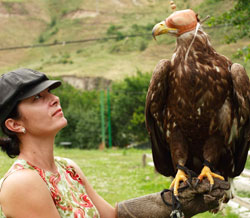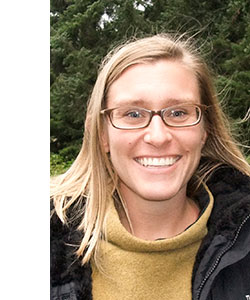Katia G. Karadjova, Librarian, College of Natural Resources & Sciences

Where are you originally from?
I was born and raised in Bulgaria, Eastern Europe.
Where did you complete your education?
MS Physics – Sofia University, Sofia, Bulgaria
MLIS (Masters in Library & Information Science) – San Jose State University (SJSU)
Where did you work prior to coming to HSU?
University Library, CSU San Marcos and University Library, CSU Long Beach
What do you feel are are your specific areas of expertise?
Information Literacy Instruction
Information Resources
International Relations
What attracted you to Humboldt State?
Tenure-track position in the CSU system and the beautiful nature.
What do you do in your free time?
Write poetry and fiction. Film documentaries and short fiction movies. I also enjoy drawing and painting, dancing, playing racquetball and tennis, outdoor activities, and, last but not least, visiting places all over the world.
If you weren’t a librarian, what would you be?
Filmmaker
What superpower would be most valuable to your work?
Mind reading :-) just kidding. A photographic memory.
Sarah Ray, Department of Geography

Where are you originally from?
Santa Monica, California
Where did you complete your education?
University of Oregon
Where have you taught prior to coming to HSU?
University of Alaska Southeast in Juneau
What do you feel are are your specific areas of expertise?
Environmental humanities, environmental justice cultural studies, new cultural geography, feminist theory, environmental history, and eco-media studies.
What classes are you teaching this year?
Introduction to Environmental Studies, Research and Analysis in Environmental Studies and the Environmental Studies Capstone.
What attracted you to Humboldt State?
The beautiful location, the diverse student body, the University’s emphasis on environmental and social responsibility, and the complex social-environmental issues of the area.
What do you do in your free time (if you have any) outside the classroom?
Play with my 3-year-old daughter, spend time with my family, go rockpooling, camp, cook, exercise, and try to achieve the elusive work-life balance.
What is your favorite classroom technique to engage students?
Ask them to move to a part of the classroom that represents their position on controversial statements like “women are closer to nature than men.” Then I ask them to share why they “agree” or “disagree” with the statement, and allow them to move around as they change their minds. This gets them out of their seats and their blood flowing, and embodies the experience of intellectual inquiry, which is about taking positions within a community, but being willing to move your mind around.
What is the best thing about being a university professor?
Working with undergraduates. They are at an incredible stage in their lives when one world is opening up to them as the one they’ve known forever is shifting in focus, maybe even shattering. College is a scary and thrilling time and place. It’s extremely gratifying to watch students go through the rite of passage that is college, and I always hope I can help them survive it, and maybe even love it.
Where is the strangest place you’ve done research?
The internet. It’s mundane to us, but I do really find it far stranger than any physical, material place I’ve been. Also, I do nearly all my research there, so I’m not very glamorous on that front.
If you weren’t an HSU professor, what would you be?
An activist/writer on issues of environmental toxicity or an editor for an environmental magazine like Orion. I’d have to write and reach people.
What superpower would be most valuable to your research?
Time Creation: the ability to make more time to do more stuff, including doing nothing.